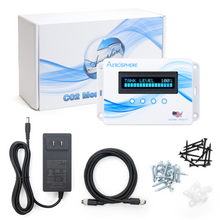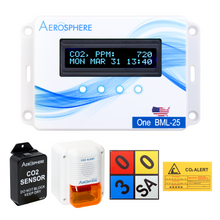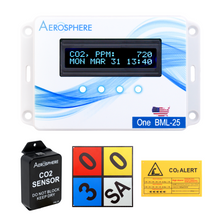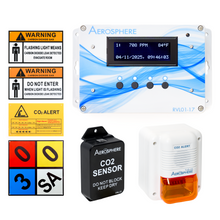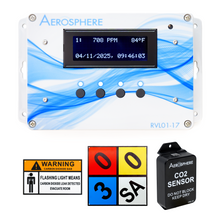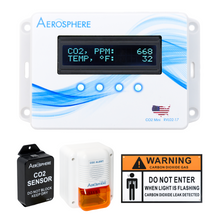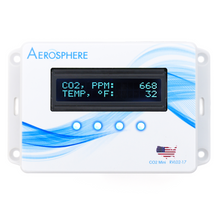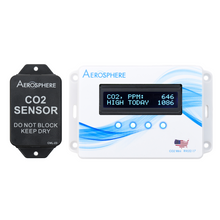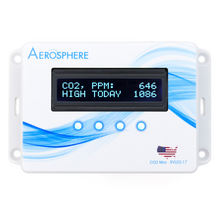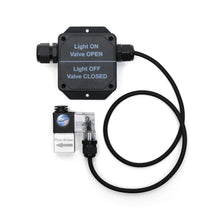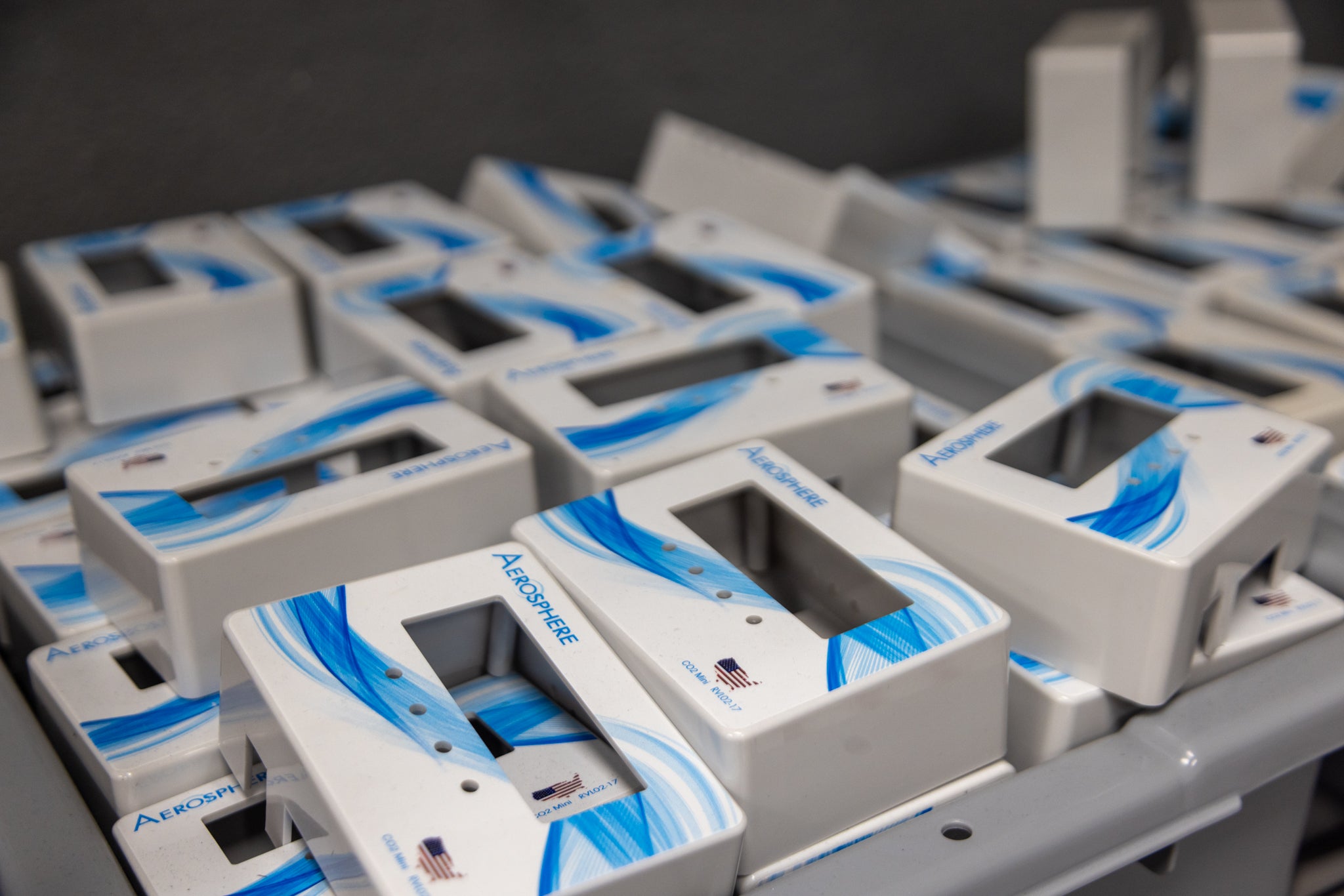Why Your Grow House Could Benefit from an HVAC Controller
An HVAC controller is one of the smartest investments a grow house can make for CO2 management and safety. By integrating with your Aerosphere® monitoring system, it automates ventilation, shuts off gas flow during leaks, and ensures full compliance with IFC and NFPA codes. This seamless connection between CO2 detection and HVAC response keeps workers safe, protects crops, and simplifies inspections so you can focus on growth, not maintenance.

Running a grow house requires a delicate balance of temperature, humidity, and carbon dioxide (CO2) levels. While lighting and irrigation get a lot of attention, CO2 management is just as important, and it’s an area where many grow operations struggle.
An HVAC controller can transform the way your grow house integrates ventilation, CO2 enrichment, and safety compliance. Here’s why including an HVAC controller into your CO2 monitoring system isn’t just a nice-to-have, it’s one of the smartest investments you can make for plant health, worker safety, and regulatory compliance.
The Importance of CO2 Management in Grow Houses
Plants thrive when CO2 levels are kept within a precise range. Too little, and growth slows dramatically. Too much, and you risk not only plant damage but also creating an unsafe environment for workers.
Typical grow houses aim for CO2 levels between 800-1200 ppm during the light cycle, but if a leak or over-enrichment occurs, levels can quickly rise above safe limits. At 5,000 ppm, OSHA sets an 8-hour exposure limit. Levels above 30,000 ppm can become immediately dangerous to life and health (IDLH).
Maintaining this balance manually is difficult and this is where an HVAC controller shines.
Fixed HVAC Controller Demo by CO2 Monitor Marketing
What an HVAC Controller Does
An HVAC controller is the “bridge” between your CO2 monitoring system and your facility’s ventilation equipment. When paired with the Aerosphere® Primary Monitor, it can:
-
Activate multiple ventilation circuits: Trigger exhaust fans, fresh air intakes, or dampers when CO2 levels rise above a set threshold.
-
Shut off CO2 at the source: If there’s a leak, the controller can stop flow from the tank or manifold automatically.
-
Maintain compliance: Meet IFC, NFPA, and local fire codes that require automatic ventilation activation at specified alarm levels.
How to Integrate an HVAC Controller
Integrating an HVAC controller doesn’t have to be complicated. Here’s a typical workflow:
-
Site Survey & Assessment – A technician documents your current monitoring system, ventilation layout, and CO2 source locations.
-
Wiring & Installation – The controller is connected to your Aerosphere® Primary Monitor via the red RJ45 port.
-
Relay Setup – Up to three ventilation circuits can be programmed to activate at specific CO2 levels.
-
Testing & Verification – Leak simulation ensures ventilation and shutoff function correctly before sign-off.
- Documentation – As-built drawings and permits are updated for your fire department records.

Benefits for Grow House Operators
1. Worker Safety
A controller ensures that if CO2 levels go outside the ideal growth range and create a health hazard, the ventilation system is activated to return the area to safe conditions, preventing over-exposure. CO2 enrichment can quickly create dangerous conditions if left unchecked. By integrating CO2 shutoff valves and ventilation activation, a controller helps protect employees from accidental overexposure and supports OSHA compliance.
2. Code Compliance and Inspections
Many jurisdictions require automatic ventilation tied to CO2 monitoring systems for any facility storing more than 100 lbs of compressed CO2. An HVAC controller is the most reliable way to satisfy:
-
IFC Section 5307: Automatic ventilation and emergency alarm requirements
-
NFPA: Gas detection and ventilation interlock standards
- Local AHJ requirements for emergency shutoffs and alarm activation
4. Peace of Mind
Instead of worrying about CO2 levels after hours, you can rely on your monitoring system to take action automatically. This reduces downtime, prevents crop loss, and avoids costly emergency calls.
Real-World Example: Automatic Response Saves a Crop
One grow house we worked with had a CO2 line leak after hours. Without an HVAC controller, the system could only alarm locally, no ventilation activated, and CO2 levels spiked overnight. The next morning, staff found stressed plants and a system that needed to be manually reset.
After installing the Aerosphere® HVAC Controller, the facility was able to:
-
Shut off CO2 at the tank as soon as the alarm triggered
-
Open ventilation circuits to purge the room automatically
-
Reset the system remotely, preventing crop damage and employee exposure
Why Work With Aerosphere®
At Aerosphere®, we handle compliance from start to finish so you don’t have to worry about missing a single requirement. Our team provides permit diagnostics, site surveys, drafting, installation, and inspection coordination to guarantee your CO2 system meets IFC, NFPA, and local jurisdictional codes. We work directly with your fire department or AHJ, prepare all required drawings and paperwork, and ensure your HVAC controller passes inspection the first time. Plus, we offer annual recertifications and service renewals so your system stays compliant year after year.
Get Started with a Compliance Consultation from us!
Final Thoughts
An HVAC controller is more than just a piece of equipment. It’s the key to creating a safe, compliant, and efficient grow operation. By automating ventilation, protecting employees, and keeping CO2 at optimal levels, you can maximize yield while staying on the right side of fire code and OSHA requirements.
If your grow house is still relying on manual ventilation or standalone alarms, now is the time to upgrade.
Learn More About the Aerosphere® HVAC Controller and buy one today!

